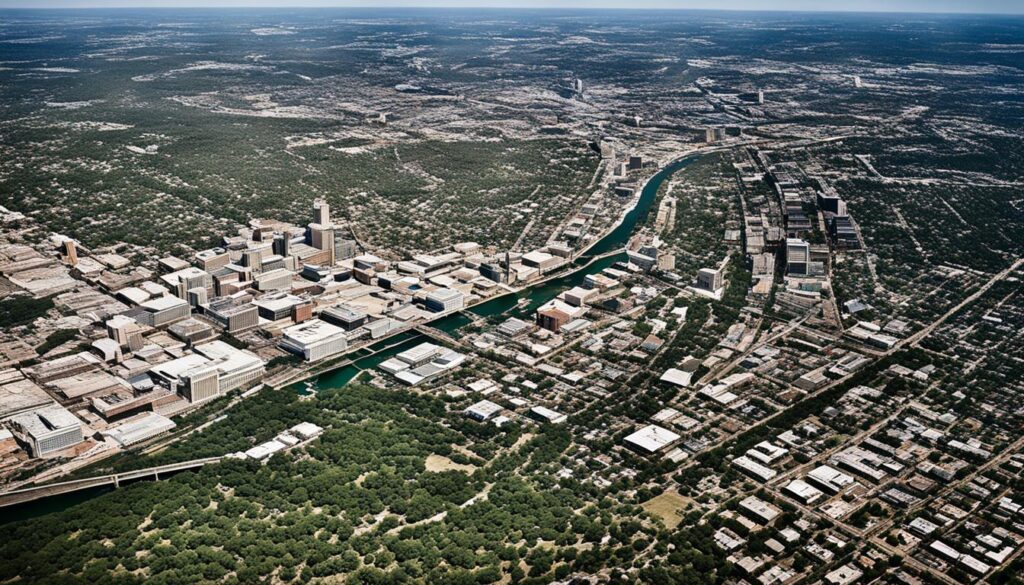Elevation in Austin TX – Learn the Facts
Austin, Texas, has elevations from about 425 to 1,000 feet above sea level. The elevation in Austin TX differences are due to the Balcones Fault. It makes East Austin flat and West Austin hilly. The city’s lowest point, near Onion Creek, sits at 382 feet. The highest point reaches 1,114 feet. This mix makes Austin’s landscape special, offering various experiences for everyone.
Key Takeaways
- The elevation in Austin TX ranges from 425 feet to 1,000 feet above sea level.
- The Balcones Fault significantly influences the terrain elevation in Austin TX.
- East Austin is flat, while West We obtain Austin is hilly.
- The lowest point is near Onion Creek at 382 feet, and the highest is 1,114 feet.
- Austin’s varied elevation contributes to its unique character and diverse outdoor activities.
Overview of Austin’s Elevation
Austin’s landscape is full of variety, making the city truly special. Its highest elevation in Austin TX stands out, echoing the motto, “Keep It Weird.” The Colorado River’s calm shores sit at 689 feet. The city’s rolling hills reach higher, offering many experiences for everyone.
An elevation map Austin TX shows the area’s diverse heights. Lake Travis lies peacefully at 912 ft, while Pflugerville buzzes at 705 ft. The Shingle Hills soar to 1,253 ft, the highest elevation in Austin TX. They offer stunning views and exciting hikes.
| Location | Average Elevation (ft) |
|---|---|
| Lake Travis | 912 |
| Pflugerville | 705 |
| Lago Vista | 823 |
| Pace Bend Park | 735 |
| Shingle Hills | 1,253 |
| Hill of Life Falls | 764 |
The elevation map Austin TX also points out lower areas like Hornsby Bend at 449 ft. And East Boggy Creek Greenbelt at 472 ft. These elevations impact the city’s weather and natural landscapes. They also offer diverse activities. From peaceful walks in Walton Creek Park (702 ft) to downtown adventures around 489 ft high, elevation shapes Austin.
Austin’s varied elevations feed its unique vibe. With calm lakes, thrilling hills, and lively cities, elevation is key to Austin’s identity and way of life.
Influence of the Balcones Fault on Austin’s Topography
The Balcones Fault is key to Austin, TX’s topography. It clearly marks the difference between East and West Austin. This fault line stretches from the Dallas/Fort Worth area to beyond Austin. It shapes Austin’s varied heights.
This fault impacts the area’s geography, landscape, and weather. It makes Austin’s scenery unique for both locals and visitors.

The Role of the Balcones Fault
The Balcones Fault shaped Austin’s land for millions of years. It started changing the terrain in the Miocene Period. Over time, it lifted the earth up to 1,000 feet in small stages.
This lifting is especially noticeable in Travis County by the Colorado River. It created East Austin’s flatlands and West Austin’s hills.
Impact on Local Geography
The Balcones Fault also changes the local weather and the area’s topography. Storms weaken and then strengthen as they cross the fault zone. This effect influences Austin’s weather systems.
Furthermore, it affects water flow, causing flash floods in some locales. Visible signs of the fault can be seen in various areas, like Loop 360 and MoPac.
| Location | Elevation Change | Geological Features |
|---|---|---|
| Travis County | 700 to 1,000 feet uplift | Pronounced near Colorado River |
| Loop 360 and MoPac | 170 feet of exposed rock | Fractured and folded rocks |
| Barton Springs | N/A | 53 million gallons per day flow |
Elevation in Austin TX
The elevation in Austin, Texas, varies widely, adding charm to the city. Ranging from 382 feet to 1,114 feet, it offers everything from peaceful waterfronts to thrilling hilltop activities. This variety is key to Austin’s appeal, giving us different terrains and activities to enjoy.

Austin sits roughly at 489 feet above sea level, blending diverse landscapes. This range in elevation supports both level plains and higher grounds. With a dense population of 3,006.36 per square mile, Austin utilizes its varied elevations well, creating a vibrant city life.
The city’s diverse elevations also boost its economy. Hosting companies like 3M, AMD, Amazon, and Tesla, the metro area’s economy is strong. With a $222.1 billion GDP in 2022, the varied landscapes support everything from large tech firms to small startups.
Austin’s unique topography benefits the education sector too. Over 50,000 students at the University of Texas explore this terrain firsthand. Sports fans also got Austin FC in 2021, raising the city’s vibrant lifestyle and connection with its natural elevations.
| Criteria | Data |
|---|---|
| Elevation of Austin, Texas | 489 ft (149 m) |
| Population of Austin (2022) | 974,447 |
| Population Density | 3,006.36/sq mi (1,160.76/km2) |
| Metro Area Population | 2,473,275 |
| GDP of Austin (MSA) in 20222 | $222.1 billion |
| Fortune 500 Companies | 3M, AMD, Amazon, Apple, Facebook (Meta), Google, IBM, Intel, NXP Semiconductors, Oracle, Tesla, Texas Instruments, Whole Foods Market |
| University of Texas Students | Over 50,000 |
| Austin FC | Founded in 2021 |
Tools and Methods for Measuring Elevation
Measuring elevation accurately is essential in places like Austin, TX. Advanced tools and methods at the Near Surface Observatory (NSO) make this possible.

Altimeters and Their Use
Altimeters are key in measuring elevation. They work by sensing atmospheric pressure changes. In our phones today, they help both hobbyists and experts get exact height measurements. This way, keeping track of Austin’s terrain changes is easy.
Digital Elevation Models (DEM)
Digital Elevation Models (DEM) provide a detailed look at the earth’s surface using satellite data. They are great for accurately pinpointing Austin’s height above sea level. These models support the NSO in studying various areas like coastal risks and wetlands. Technologies like lidar and radar interferometry offer precise elevation insights.
The NSO also uses methods like ground-penetrating radar and flights for detailed surveys. This boosts the exactness of elevation data, especially in Austin. Thanks to this advanced tech, we understand Austin’s elevation like never before.
Conclusion
Exploring Austin, TX’s elevation reveals much about its culture and land. The city stands at an average of 489 feet high. This varied height, from 425 feet to around 1,000 feet, comes from the Balcones Fault. Such diversity let people enjoy outdoor fun by the river or view stunning scenes from high points.
Austin’s life buzzes with energy, partly due to its geography. Its population hit 974,447 in 2022. This growth fills the city, which has over 3,000 people per square mile. Famous schools like the University of Texas at Austin and great job opportunities make it a key city globally.
To know Austin’s land well, using altimeters and Digital Elevation Models (DEM) is key. These tools help plan the city better and improve life. As Austin grows, its varied heights shape its charm and progress. For those wanting to dive into Austin’s elevation, these technologies are vital for exploration.







